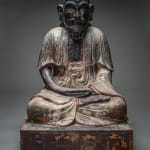Wooden Sculpture of Bodhidharma, 15th Century CE - 17th Century CE
Wood
78.1 x 48.3 x 45.7 cm
30 3/4 x 19 1/8 x 18 in
30 3/4 x 19 1/8 x 18 in
X.0703
Further images
The figure of the first patriarch of Zen Buddhism stands on a raised footed platform decorated with geometric design against a red background, the body in a highly controlled meditative...
The figure of the first patriarch of Zen Buddhism stands on a raised footed platform decorated with geometric design against a red background, the body in a highly controlled meditative padmasana posture, hands in dhyana mudra, the beard and long moustaches pointing at the Indian origin of Bodhidharma, his bare chest betraying the signs of ascetic fasting.
Bodhidharma in Sanskrit means virtuous and sagacious. It is also the name of a rare tree in India, the bodhi tree which has become famous and known as the tree of wisdom as Sakyamuni became enlightened under its shade. This luohan was born under such a tree and was given the name of Bodhidharma. Legend has it that Bodhidharma was responsible for spreading Buddhism to the East Indies and has since been venerated as the first patriarch of Chan (Zen) Buddhism.
One of the most fascinating figures in the history of Buddhism, Bodhidharma is credited with bringing Buddhism to China and founding Chan Buddhism (in China), which later became known as Zen Buddhism in Japan. He was born in Southern India, a son of a wealthy Brahmin. He later became a monk and, alongside the development of his prodigious spiritual powers, he came to consider that the true value of the religious experience lay in experience rather than scripture. With this conviction in his mind perhaps he set out for China, arriving there in around 520 C.E.
The stories that have been passed down paint a rather larger than life figure. One such story has it that to stop himself falling asleep in meditation he cut off his eyelids. Another tells that his legs fell off after nine years of unceasing meditation. Though these accounts are no doubt apocryphal, they are important in that they show the significance of meditation to his religious practice. Indeed the word 'Zen' ultimately derives from the Sanskrit word dhyana which means 'meditation'. Bodhidharma emphasized direct methods rather than over-reliance on scriptures. Consequently, he emphasized the importance of a teacher to help one realize the Buddha nature.
In addition to this renewed commitment to meditation as a way of gaining insight into the true nature of reality, Bodhidharma taught that within all beings is the Buddha nature. Unfortunately, the Buddha nature is obscured by the poisons of greed, hatred and delusion. To see the Buddha nature, we must let go of desire. Paradoxically, it's not something we can grasp. Once we try to grasp it we are caught up in the web of desire. It's not something 'out there'. It's something here and now, to be uncovered through the practice of meditation. The teachings of Bodhidharma are encapsulated in the following verses, written after his death but attributed to him:
A special transmission outside the scriptures;
Depending not on words and letters;
Pointing directly to the human min Seeing into one's nature, one becomes a Buddha.
Bodhidharma in Sanskrit means virtuous and sagacious. It is also the name of a rare tree in India, the bodhi tree which has become famous and known as the tree of wisdom as Sakyamuni became enlightened under its shade. This luohan was born under such a tree and was given the name of Bodhidharma. Legend has it that Bodhidharma was responsible for spreading Buddhism to the East Indies and has since been venerated as the first patriarch of Chan (Zen) Buddhism.
One of the most fascinating figures in the history of Buddhism, Bodhidharma is credited with bringing Buddhism to China and founding Chan Buddhism (in China), which later became known as Zen Buddhism in Japan. He was born in Southern India, a son of a wealthy Brahmin. He later became a monk and, alongside the development of his prodigious spiritual powers, he came to consider that the true value of the religious experience lay in experience rather than scripture. With this conviction in his mind perhaps he set out for China, arriving there in around 520 C.E.
The stories that have been passed down paint a rather larger than life figure. One such story has it that to stop himself falling asleep in meditation he cut off his eyelids. Another tells that his legs fell off after nine years of unceasing meditation. Though these accounts are no doubt apocryphal, they are important in that they show the significance of meditation to his religious practice. Indeed the word 'Zen' ultimately derives from the Sanskrit word dhyana which means 'meditation'. Bodhidharma emphasized direct methods rather than over-reliance on scriptures. Consequently, he emphasized the importance of a teacher to help one realize the Buddha nature.
In addition to this renewed commitment to meditation as a way of gaining insight into the true nature of reality, Bodhidharma taught that within all beings is the Buddha nature. Unfortunately, the Buddha nature is obscured by the poisons of greed, hatred and delusion. To see the Buddha nature, we must let go of desire. Paradoxically, it's not something we can grasp. Once we try to grasp it we are caught up in the web of desire. It's not something 'out there'. It's something here and now, to be uncovered through the practice of meditation. The teachings of Bodhidharma are encapsulated in the following verses, written after his death but attributed to him:
A special transmission outside the scriptures;
Depending not on words and letters;
Pointing directly to the human min Seeing into one's nature, one becomes a Buddha.









